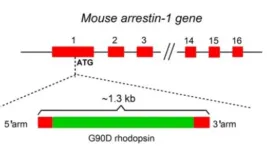(Press-News.org) In what they believe is a solution to a 30-year biological mystery, neuroscientists at Johns Hopkins Medicine say they have used genetically engineered mice to address how one mutation in the gene for the light-sensing protein rhodopsin results in congenital stationary night blindness.
The condition, present from birth, causes poor vision in low-light settings.
The findings, published May 14 in Proceedings of the National Academy of Sciences, demonstrate that the rhodopsin gene mutation, called G90D, produces an unusual background electrical “noise” that desensitizes the eye’s rods, those cells in the retina at the back of the eye responsible for nighttime vision, thus causing night blindness.
The identification of the unusual electrical activity could “provide future targets for therapeutic interventions,” the study’s authors write.
These electrical events could help scientists better understand how the eye’s rods and cones function, says King-Wai Yau, Ph.D., professor in the department of neuroscience at the Johns Hopkins University School of Medicine.
The research was led by Yau and postdoctoral fellow Zuying Chai.
“The G90D mutation in rhodopsin is known to produce background electrical noise to desensitize rods, but the nature of the ‘noise’ and its precise molecular source have not been resolved for almost 30 years,” Yau says. “We were able to help solve the mechanism of this disease with a mouse model with a very low expression level of G90D rhodopsin.”
When comparing the low expression level of G90D found in genetically engineered mice versus the level of G90D found in human patients with this night blindness, the authors concluded that the unusual electrical activity with a low amplitude but extremely high frequency may be the greatest contributor to the disease in people.
Besides the unusual electrical noise, rhodopsin is known to produce another type of electrical activity called spontaneous thermal isomerization, in which the thermal energy inside the rhodopsin molecule triggers rhodopsin to activate at random. Contrasting the observed unusual electrical activity, the spontaneous isomerization of G90D rhodopsin demonstrated a high amplitude but low frequency. In their experiments, the researchers found that the spontaneous-isomerization rate of G90D rhodopsin is about two hundred-fold higher than normal rhodopsin, but their rod-adapting effect is not high enough to contribute significantly to night blindness in humans.
In most circumstances, rods are very sensitive to light, but in people with night blindness, the rods cannot accurately detect changes in light, and fail to function in the dark. People with this condition require brighter light to see in low-light settings, Yau said.
For decades, although researchers knew about the G90D mutation, they had difficulty determining how it caused night blindness because prior mouse models with this mutation would generate a high level of background noise, producing effects similar to background light, which the mouse’s rods quickly adapt to. That made it difficult for researchers to accurately measure the mutation’s signaling effects.
To circumvent this issue, the researchers at Johns Hopkins Medicine genetically modified mice to have a low expression of G90D, a level equal to .1% of normal rhodopsin found in the natural population of mice.
This enabled the researchers to distinguish between different types of activity produced in mice with the G90D mutation as if little or no equivalent background light were present.
The scientists used a high-resolution method to record the electrical activity in individual rods in the mouse retina, which they accessed with an ultra-tiny glass pipette — the width of about one-seventieth the size of a human hair — filled with saline solution capable of conducting electricity.
“You can actually see these events,” Yau says. “We used a very special technique called suction-pipette recording to record the activity at such a high resolution that if one rhodopsin molecule isomerizes, or activates, we can see it, because it causes a change in electrical current.”
G90D is one of four mutations of rhodopsin associated with night blindness. First author Chai says the next steps are to identify how other rhodopsin mutations, T94I, A292E and A295V, lead to this condition.
“The mechanism that causes G90D night blindness could be similar in the three other rhodopsin mutations that cause this condition,” Chai says.
Other scientists who contributed to the research include Yaqing Ye, Daniel Silverman and Randall Reed of Johns Hopkins, and Kasey Rose, Alana Madura and Jeannie Chen from the University of Southern California.Funding for the study was provided by the National Institutes of Health grant EY006837, the António Champalimaud Vision Award, Portugal, the Multiphoton Imaging Core at Johns Hopkins, the Daniel Nathans Scientific Innovator Award from the Johns Hopkins University School of Medicine, and the Beckman-Argyros Vision Award from the Arnold and Mabel Beckman Foundation.
DOI: https://doi.org/10.1073/pnas.2404763121
END
Study suggests high-frequency electrical ‘noise’ results in congenital night blindness
2024-05-16
ELSE PRESS RELEASES FROM THIS DATE:
TeltoHeart wristband, developed by Lithuanians, receives important medical device certification
2024-05-16
Teltonika’s TeltoHeart, a multifunctional smart wristband system developed in cooperation between Lithuanian industry and universities has been given the CE MDR (Class IIa) medical device certification. This approval confirms that the product meets the comprehensive quality standards for medical devices and opens up new markets worldwide for this innovative product.
"This is an important recognition that we have been working towards since the start of this project in 2020. The CE MDR certification proves that TeltoHeart is a safe ...
Unique brain circuit is linked to Body Mass Index
2024-05-16
· One region is related to olfaction and reward, the other to negative feelings like pain · When the connection between these brain regions is weak, people have higher BMI
· Food may continue to be rewarding, even when these individuals are full
CHICAGO --- Why can some people easily stop eating when they are full and others can’t, which can lead to obesity?
A Northwestern Medicine study has found one reason may be a newly discovered structural connection ...
Noise survey highlights need for new direction at Canadian airports #ASA186
2024-05-16
OTTAWA, Ontario, May 16, 2024 – The COVID-19 pandemic changed life in many ways, including stopping nearly all commercial flights. At the Toronto Pearson International Airport, airplane traffic dropped by 80% in the first few months of lockdown. For a nearby group of researchers, this presented a unique opportunity.
Julia Jovanovic will present the results of a survey conducted on aircraft noise and annoyance during the pandemic era Thursday, May 16, at 11:10 a.m. EDT as part of a joint meeting of the Acoustical Society of America and ...
COSPAR partners with LASP for 1st COSPAR Center of Excellence
2024-05-16
Partnering with LASP was an obvious decision for COSPAR. LASP stands out with its distinguished track record in space science research, having deployed scientific instruments to every planet in our solar system, the Sun and numerous moons. In particular, LASP has been at the forefront of pioneering Cube-Sat missions, consistently achieving remarkable success in gathering scientific data. With seven completed CubeSat missions and nine more in active development or orbit, LASP has demonstrated unparalleled expertise in this field. ...
Building a better sarcasm detector #ASA186
2024-05-16
OTTAWA, Ontario, May 16, 2024 – Oscar Wilde once said that sarcasm was the lowest form of wit, but the highest form of intelligence. Perhaps that is due to how difficult it is to use and understand. Sarcasm is notoriously tricky to convey through text — even in person, it can be easily misinterpreted. The subtle changes in tone that convey sarcasm often confuse computer algorithms as well, limiting virtual assistants and content analysis tools.
Xiyuan Gao, Shekhar Nayak, and Matt Coler of Speech Technology Lab at the University of Groningen, Campus Fryslân developed a multimodal algorithm ...
Natural toxins in food: Many people are not aware of the health risks
2024-05-16
Many people are concerned about residues of chemicals, contaminants or microplastics in their food. However, it is less well known that many foods also contain toxins of completely natural origin. These are often chemical compounds that plants use to ward off predators such as insects or microorganisms. These substances are found in beans and potatoes, for example, and can pose potential health risks. However, according to a recent representative survey by the German Federal Institute for Risk Assessment (BfR), only just under half of the respondents (47 per cent) were even aware of plant toxic substances. The BfR Consumer Monitor Special on naturally occurring plant toxins ...
Archaeology: Egyptian pyramids built along long-lost Ahramat branch of the Nile
2024-05-16
31 pyramids in Egypt, including the Giza pyramid complex, may originally have been built along a 64-km-long branch of the river Nile which has long since been buried beneath farmland and desert. The findings, reported in a paper in Communications Earth & Environment, could explain why these pyramids are concentrated in what is now a narrow, inhospitable desert strip.
The Egyptian pyramid fields between Giza and Lisht, built over a nearly 1,000-year period starting approximately 4,700 years ago, now sit on the edge of the inhospitable Western Desert, part of the Sahara. ...
Effectiveness of a web-based cognitive behavioral self-help intervention for binge eating disorder
2024-05-16
About The Study: In this randomized clinical trial of a web-based self-help intervention for patients with binge eating disorder, the findings confirmed its effectiveness in reducing binge eating episodes and improving various mental health outcomes, highlighting a scalable solution to bridge the treatment gap for this condition.
Corresponding Author: To contact the corresponding author, Luise Pruessner, M.S., email luise.pruessner@psychologie.uni-heidelberg.de.
To access the embargoed study: Visit our For The Media website at this link ...
Physician and AI chatbot responses to cancer questions from social media
2024-05-16
About The Study: The findings of this study suggest that chatbots can generate quality, empathetic, and readable responses to patient questions comparable to physician responses sourced from an online forum. Further research is required to assess the scope, process integration, and patient and physician outcomes of chatbot-facilitated interactions.
Corresponding Author: To contact the corresponding author, Srinivas Raman, M.D., M.A.Sc., email srinivas.raman@rmp.uhn.ca.
To access the embargoed study: Visit ...
How did sabre-toothed tigers acquire their long upper canine teeth?
2024-05-16
In a groundbreaking study, an international team led by scientists from the University of Liège has investigated the evolutionary patterns behind the development of sabre teeth, with some unexpected results along the way. A study that enriches our understanding of the Earth's past, but also documents the mechanisms leading to evolutionary convergence.
Sabre teeth, those iconic elongated upper canine teeth, have long fascinated both scientists and the general public, notably because they have appeared several times in the fossil record, including two particularly well-known lineages of sabre-toothed tigers: the felids (the family of ...





